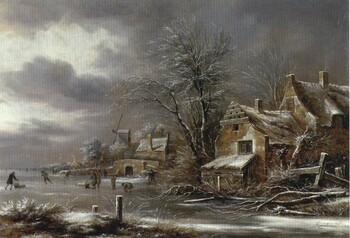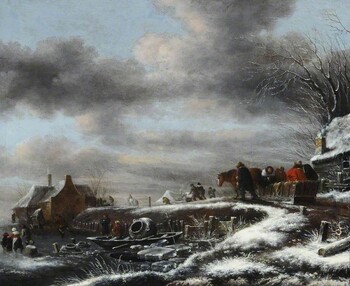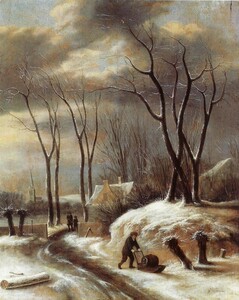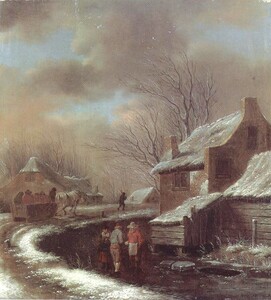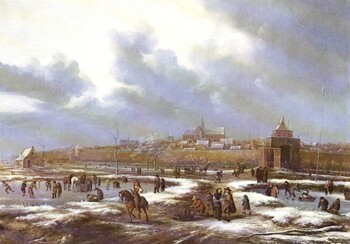Klaes Molenaer
Winter landscape
Oil on canvas : 66 X 81,3 cm
Unsigned
UK, Kingston upon Hull, Ferens Art Gallery Museum
This is a comparative item
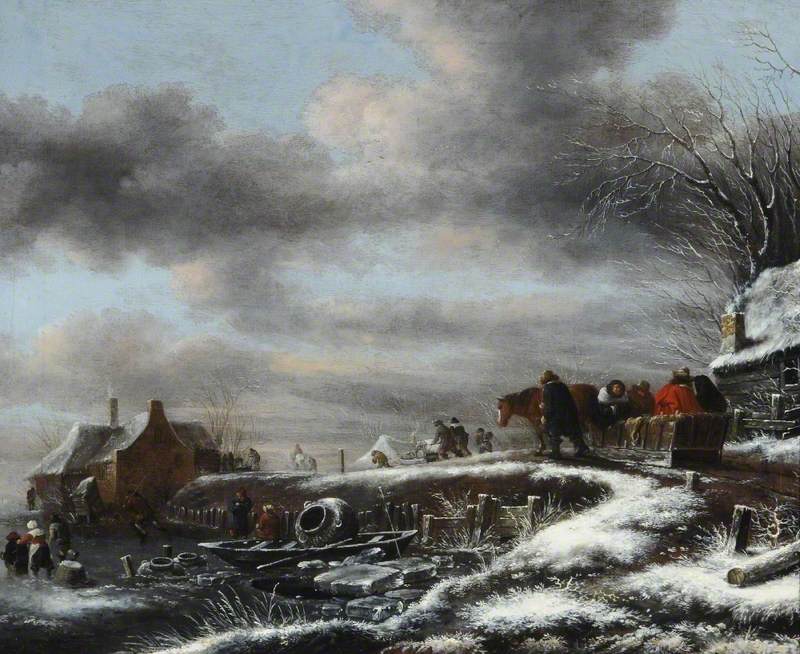
Painting for Sale
Molenaer, Attributed to Klaes
"A winter landscape with a view of Haarlem in the back"
In short
Klaes Molenaer, who remained active all his life in his native Haarlem, was one of the main Dutch winter landscape painters during the third quarter of the 17th century. He is well known for his anecdotic approach, which was to have a big influence both on his fellow townsman Thomas Heeremans and on 19th century Romantic landscape painters.
A related winter view on Haarlem, but painted on canvas, was sold at Sotheby’s Amsterdam, 4/11/03, for over 15.000 €.
About Klaes Molenaer
Also known as Nicolaes or Claes Molenaer
Dutch painter
Haarlem before 1630 – 1676 Haarlem (he was actually buried December 31st 1676).
Painter of the everyday outside activities and moments of leisure of the population of the countryside and small towns of the Dutch Republic, set in attractive summer and winter landscapes, and in beach scenes; there are also a few real genre scenes known by him.
Klaes Molenaer’s winter landscape served as an example for many Romantic,19th century Dutch, German and Belgian painters who endlessly ruminated his art.
His earliest dated painting is from 1644.
He became a member of the Painter's Guild of Saint Luke of Haarlem in 1651.
He was influenced by Jan van Goyen, Salomon and Jacob van Ruisdael and by Isaac van Ostade.
He is said to have been a nephew of those other Molenaer painters of Haarlem, Bartholomeus and Jan Miense. Those brothers both painted genre scenes. Klaes may have worked together with Jan Miense on occasion.
Klaes Molenaer strongly influenced Thomas Heeremans, whom dated works are known by between 1675 and 1692.
About our painting
Our landscape stands close to an unsigned painting sold at Sotheby’s Amsterdam, 4/11/03, for 15.404 €. Both paintings hold similar characteristics of signed works by Klaes Molenaer.
About 17th century winters
North Western Europe went through a small ice age from circa 1550
until the middle of the 19th century.
The first very strong winter had been in 1564/1565.
Two thirds of the winters in the Low Countries between 1600 and 1700 were very cold with long periods of frost and snow. This explains the popularity of ice skating and its representation in paintings and engravings during the 17th century. January 1684 must have been the coldest month of that century.
We should also mention that a quarter to a third of the 17th century winters have been mild, especially in the second quarter of the century.
About the attraction of painted winter scenes
The harsh weather conditions during winter change the light, the air, the atmosphere, the colours. This must have been a first challenge for painters.
Fifty five percent of Holland lays under the level of the sea. The country was/is constantly fighting to evacuate water from the land: there are numerous rivers and canals. Frozen water ways offered people the chance to have a good time on the ice: a mix of people from all social layers would go for a stroll on the ice, others would go ice skating, go for a ride in a sledge, play kolf (the popular forerunner of ice hockey).
Merchants would set up shops on the ice. People could eat and drink in a typically Dutch “koek-en-zopie” tent. This term refers to the food and beverage that one could and still can buy while ice skating. Its best known drink was “zopie”; that was made of “bock”, which was a strong German lager, mingled with rum.
Daily life was partly transposed onto the ice: goods and passengers were ferried by sledge, instead of by carts or boats; the water supply would be ensured by a makeshift well that had been cut into the ice.
It is clear that the atmospheric conditions, the pleasures and businesses of winter formed a very attractive subject for the painters, for their clients and still do for our clients.
Painted winter landscapes had initiated in Flanders with Pieter Brueghel the Elder in the third quarter of the 16th century. Following the iconoclast riots and the Sack of Antwerp in 1576 Flemish Protestants fled in large numbers to Holland. Amongst them many painters. Hans Bol and David Vinckboons brought this new subject to Holland, especially to Amsterdam.
Seventeenth century Dutch winter landscapes can be divided in several categories according to the emphasis stressed by the painter: did he go for anecdotic, Flemish-inspired genre scenes or for a naturalistic, atmospheric, sober, sometimes monochrome approach or of course for a blend of both.
To the first group belong Hendrick and Barent Avercamp, Adriaen van de Venne, Arent Arentsz., nicknamed Cabel, the early Jan van Goyen, Isaak van Ostade, Jan and Abraham Beerstraaten, Klaes Molenaer and Thomas Heeremans.
To the second group Esaias van de Velde, monochrome works of Jan van Goyen, Salomon and Jacob van Ruysdael, Aert van der Neer and Jan van de Capelle.
Many museums posses winter landscapes by Klaes Molenaer.
Why should you buy this painting?
Because it is a very nice and important example of the art of one of the main representatives of 17th century Dutch winter landscape painting.
Comparative paintings
Click photos for more details


